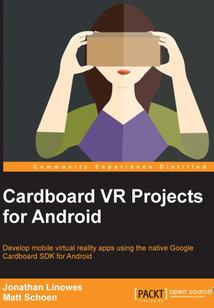舉報(bào) 

會(huì)員
Cardboard VR Projects for Android
最新章節(jié):
Index
ThebookisforestablishedAndroiddeveloperswithagoodknowledgelevelofJava.NopriorOpenGLorgraphicsknowledgeisrequired.NopriorexperiencewithGoogleCardboardisexpected,butthosewhoarefamiliarwithCardboardandarelookingforprojectstoexpandtheirknowledgecanalsobenefitfromthisbook.
目錄(137章)
倒序
- coverpage
- Cardboard VR Projects for Android
- Credits
- About the Authors
- About the Reviewers
- www.PacktPub.com
- eBooks discount offers and more
- Preface
- What this book covers
- What you need for this book
- Who this book is for
- Conventions
- Reader feedback
- Customer support
- Chapter 1. Virtual Reality for Everyone
- Why is it called Cardboard?
- The spectrum of VR devices
- A gateway to VR
- The value of low-end VR
- Cardware!
- Configuring your Cardboard viewer
- Developing apps for Cardboard
- An overview to VR best practices
- Summary
- Chapter 2. The Skeleton Cardboard Project
- What's in an Android app?
- The Android project structure
- Getting started with Android Studio
- Creating a new Cardboard project
- Adding the Cardboard Java SDK
- The AndroidManifest.xml file
- The activity_main.xml file
- The MainActivity class
- Summary
- Chapter 3. Cardboard Box
- Creating a new project
- Hello triangle!
- 3D camera perspective and head rotation
- Repositioning the triangle
- Hello cube!
- Lighting and shading
- Spinning the cube
- Hello floor!
- Hey look at this!
- Summary
- Chapter 4. Launcher Lobby
- Creating a new project
- Adding Hello Virtual World text overlay
- Using a virtual screen
- Responding to head look
- Adding an icon to the view
- Listing installed Cardboard apps
- Highlighting the current shortcut
- Using the trigger to pick and launch the app
- Further enhancements
- Summary
- Chapter 5. RenderBox Engine
- Introducing RenderBox – a graphics engine
- Creating a new project
- Materials textures and shaders
- The Math package
- The Transform class
- The Component class
- The RenderObject component
- The Cube RenderObject component
- Vertex color material and shaders
- The Camera component
- RenderBox methods
- A simple box scene
- Cube with face normals
- The Light component
- Vertex color lighting material and shaders
- Time for animation
- Detect looking at objects
- Exporting the RenderBox package
- Summary
- Chapter 6. Solar System
- Setting up a new project
- Creating a Sphere component
- A solid color lighted sphere
- Adding the Earth texture material
- Day and night material
- Creating the Sun
- Creating a Planet class
- Formation of the Solar System
- A starry sky dome
- Fine tuning the Earth
- Changing the camera location
- Possible enhancements
- Updating the RenderBox library
- Summary
- Chapter 7. 360-Degree Gallery
- Setting up the new project
- Viewing a 360-degree photo
- Viewing a regular photo
- Putting a border frame on the image
- Loading and displaying a photo image
- Loading and displaying a photosphere image
- The image gallery user interface
- Displaying thumbnails in a grid
- Gaze to load
- Enable scrolling
- Stay responsive and use threads
- An explanation of threading and virtual reality
- Launch with an intent
- Showing/hiding the grid with tilt-up gestures
- Spherical thumbnails
- Updating the RenderBox library
- Further possible enhancements
- Summary
- Chapter 8. 3D Model Viewer
- Setting up a new project
- Understanding the OBJ file format
- Creating the ModelObject class
- Parse OBJ models
- Model extents scaling and center
- I'm a little teapot
- I'm a little rotating teapot
- Thread safe
- Launch with intent
- Practical and production ready
- Summary
- Chapter 9. Music Visualizer
- Setting up a new project
- Capturing audio data
- A VisualizerBox architecture
- Waveform data capture
- A basic geometric visualization
- 2D texture-based visualization
- FFT visualization
- Trippy trails mode
- Multiple simultaneous visualizations
- Random visualizations
- Further enhancements
- Summary
- Onward to the future
- Index 更新時(shí)間:2021-07-16 10:54:32
推薦閱讀
- 網(wǎng)絡(luò)服務(wù)器配置與管理(第3版)
- Android NDK Game Development Cookbook
- 辦公通信設(shè)備維修
- Getting Started with Qt 5
- 電腦組裝、維護(hù)、維修全能一本通(全彩版)
- Manage Partitions with GParted How-to
- 筆記本電腦維修不是事兒(第2版)
- VCD、DVD原理與維修
- The Deep Learning with Keras Workshop
- 計(jì)算機(jī)組裝與維護(hù)(第3版)
- 單片微機(jī)原理及應(yīng)用
- STM32自學(xué)筆記
- Intel FPGA權(quán)威設(shè)計(jì)指南:基于Quartus Prime Pro 19集成開發(fā)環(huán)境
- 微控制器的應(yīng)用
- 微服務(wù)架構(gòu)基礎(chǔ)(Spring Boot+Spring Cloud+Docker)
- 筆記本電腦現(xiàn)場(chǎng)維修實(shí)錄
- 詳解FPGA:人工智能時(shí)代的驅(qū)動(dòng)引擎
- DevOps實(shí)戰(zhàn):VMware管理員運(yùn)維方法、工具及最佳實(shí)踐
- Spring Cloud微服務(wù)架構(gòu)開發(fā)
- 計(jì)算機(jī)組裝與維護(hù)項(xiàng)目化教程(第二版)
- 微處理器及控制電路識(shí)圖
- Hands-On Explainable AI(XAI) with Python
- 現(xiàn)場(chǎng)總線技術(shù)及應(yīng)用
- Arduino Uno輕松入門48例
- Hands-On Natural Language Processing with PyTorch 1.x
- Arduino圖形化編程進(jìn)階實(shí)戰(zhàn)
- 32位嵌入式微處理器原理及應(yīng)用
- 數(shù)碼辦公設(shè)備檢修技能零基礎(chǔ)成長(zhǎng)
- Salesforce CRM:The Definitive Admin Handbook(Second Edition)
- KVM實(shí)戰(zhàn):原理、進(jìn)階與性能調(diào)優(yōu)

